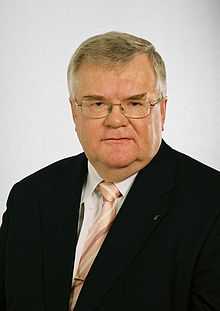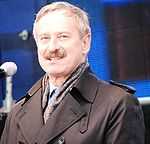Estonian parliamentary election, 1999
Estonian parliamentary election, 1999

|
|
|
|
101 seats in the Riigikogu
51 seats were needed for a majority |
| |
First party |
Second party |
|
| |
 |
 |
|
| Leader |
Edgar Savisaar |
Mart Laar |
|
| Party |
Centre |
Pro Patria Union |
|
| Last election |
16 seats |
8 seats |
|
| Seats won |
28 |
18 |
|
| Seat change |
+12 |
+10 |
|
| Popular vote |
113,378 |
77,917 |
|
| Percentage |
23.4% |
16.1% |
|
|
| |
Third party |
Fourth party |
|
| |
 |
|
|
| Leader |
Siim Kallas |
Andres Tarand |
|
| Party |
Reform |
Moderates |
|
| Last election |
19 seats |
6 seats |
|
| Seats won |
18 |
17 |
|
| Seat change |
-1 |
+11 |
|
| Popular vote |
77,088 |
73,630 |
|
| Percentage |
15.9% |
15.2% |
|
|
|
Parliamentary elections were held in Estonia on 7 March 1999.[1] The elections proved disastrous for the Estonian Coalition Party, which won only seven seats together with two of its smaller allies. The Estonian Country People's Union, which participated the election on its own list, obtained seven seats as well.
The programme of Mart Laar’s government was signed by Pro Patria Union, Reform Party, Moderates and People’s Party. The latter two merged soon after, so Mart Laar’s second government is widely known as Kolmikliit, or Tripartite coalition. Notwithstanding the different political orientation of the ruling parties, the coalition stayed united until Mart Laar resigned in December 2001, after Reform Party had broken up the same coalition in Tallinn municipality, making opposition leader Edgar Savisaar new Mayor of Tallinn. After resignation of Laar, Reform Party and Estonian Centre Party formed a coalition that lasted until next parliamentary election, 2003.
Electoral system
The threshold was 5% of the national vote. Electoral cartels were not allowed any more, but it didn't prevent a party from including members of another party in its list.
Results
| Party |
Votes |
% |
Seats |
+/– |
|---|
| Estonian Centre Party | 113,378 | 23.4 | 28 | +12 |
| Pro Patria Union | 77,917 | 16.1 | 18 | +10 |
| Estonian Reform Party | 77,088 | 15.9 | 18 | –1 |
| Moderates [a] | 73,630 | 15.2 | 17 | +11 |
| Estonian Coalition Party [b] | 36,692 | 7.6 | 7 | – |
| Estonian Country People's Union | 35,204 | 7.3 | 7 | – |
| Estonian United People's Party [c] | 29.682 | 6.1 | 6 | – |
| Estonian Christian People's Party | 11,745 | 2.4 | 0 | New |
| Russian Party in Estonia | 9,825 | 2.0 | 0 | – |
| Estonian Blue Party | 7,745 | 1.6 | 0 | 0 |
| Farmers' Assembly | 2,421 | 0.5 | 0 | – |
| Progress Party | 1,854 | 0.4 | 0 | New |
| Independents | 7,058 | 1.5 | 0 | 0 |
| Invalid/blank votes | 8,117 | – | – | – |
| Total | 492,356 | 100 | 101 | 0 |
| Registered voters/turnout | 857,270 | 57.4 | – | – |
| Source: Nohlen & Stöver |
a The Moderates' list included representatives of the Estonian People's Party.
b The Estonian Coalition Party list included members of the Estonian Country Union and the Party of Estonian Pensioners and Families.
c The Estonian United People's Party included members of the Estonian Social Democratic Labour Party and the Russian Unity Party.
References
- ↑ Nohlen, D & Stöver, P (2010) Elections in Europe: A data handbook, p574 ISBN 978-3-8329-5609-7
External links

